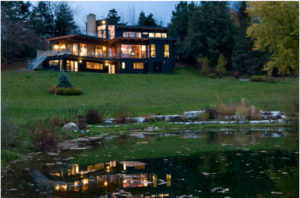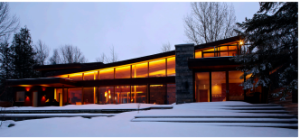Business View Magazine interviews Altius Architecture, as part of our Top Franchise Opportunities series.
Altius Architecture: Modern was seen as a four-letter word,” he said. “Fast-forward a few years and now we’re known for green architecture or sustainable building, which is very much in demand.
”So what exactly did the company have to alter? How did it change to facilitate increased demand?
The answer, surprisingly, is nothing.
“We haven’t changed anything,” Smith said. “Modern architecture has always been about sustainability.”
 Many continue to associate modernity with an architectural style as opposed to what it actually represents. Form is said to follow function, and in this regard, quality architecture assesses how a finished structure will function in its respective site, in its respective environment taking into account, the views, the thermal variances, the natural formations and a plethora of other practical concerns not the least of which is how the client actually lives.
Many continue to associate modernity with an architectural style as opposed to what it actually represents. Form is said to follow function, and in this regard, quality architecture assesses how a finished structure will function in its respective site, in its respective environment taking into account, the views, the thermal variances, the natural formations and a plethora of other practical concerns not the least of which is how the client actually lives.
Different climates, different environments, different needs ultimately effect the design and inherent efficiency, of the intended structure.
“Modern architecture has always responded to needs when historic architecture has not,” Smith said. Noting the variance between Toronto’s cold dry winters and the hot humid days of summer, he said, “These homes were never designed to be in this kind of environment, Europe is a rather temperate climate.”
A good architect recognizes that and further understands the significance of solar orientation, designing the structure to maximize lighting in the winter, while diminishing its impact in the summer. But such thinking doesn’t constitute a fraction of the finesse Altius employs upon its projects. Architects, in general, bring a depth of understanding and awareness to the building process, that when a project is complete one can more easily discern their involvement in the process.
Architectural perspective has been largely lost in today’s processes where a builder often only works from a paper drawings and attempts to interpret the instructions. “Architectural drawings are an abstraction,” Smith said. “Almost 80 percent of general contractors don’t even know how to properly read an architectural plan.”
Beyond knowledge of what could be considered classic fundamentals and principles of design, Altius Architecture provides another classic component always needed, but often under-used – collaboration.
“When we design a building, the drawing is a small portion of what is required to bring that building into being,” Smith said. “Unfortunately, some architects simply hand off hundreds of pages of specifications to a builder, and are done. If you don’t engage in the site, don’t engage in the process of building, from architectural point of view, you lose the vision of what the building is supposed to be. There’s a saying that 50 percent of the design is on paper and 50 percent is in head of architect. If the tradesman, construction manager or client cannot access the architect, they’re losing half the benefit.”
Something may also occur in the building process. Maybe a design element needs to be corrected to accommodate for an environmental condition, or a particular view is so desirable that a window placement needs to be reconsidered. What then? Smith said architectural involvement allows one to take advantage of those opportunities as they arise.
And collaboration isn’t simply a byproduct of doing business with Altius Architecture, it is the very foundation on which the business was built. On many projects construction management services are provided to the client so that the team is not only collaborative, but also fully integrated.
Smith and Altius Architecture colleagues Cathy Garrido and Trevor McIvor were enrolled together as architecture students at the University of Waterloo. For years, they respectively completed a curriculum of in-class training complemented by on-the-job internships that offered volunteer opportunities but not so many paying jobs. All had vast experience working in construction, but the transition to a traditional career in architecture seemed elusive and unnecessary.
The team of students worked on a few projects when opportunities arose – including restoration of a house purchased by Smith’s parents. The team ultimately handled all details of the building and restoration process. Along the way, the group sought to enter some of their work into architectural competitions, but needed a name by which to identify themselves, hence the moniker “Altius.”
In time, the student co-op became one of the largest employers of students at the school. When the time came to graduate and seek professional opportunities, Smith said, “We kind of looked at each other and said, ‘We’ve got a good thing going here. Let’s keep it going.’” The team shared similar values and philosophies, solid building experience complemented by understanding in new technologies and materials for application in the process.
They started taking on any manner of renovation project, primarily involving kitchens and bathrooms, and business grew. “We’re doing the same things today, but on a much bigger scale,” Smith said.
Because teamwork and collaboration undergirds their efforts, it has has also contributed to their ability to secure client relationships in both commercial and residential projects. In many cases, after a residential project is completed, clients have requested they take on a renovation or redesign project involving the client’s business. The Altius Architecture approach is creating homes that are as aesthetically alluring as they are efficient and functional, and they impart the same qualities to a commercial project, where businesses not only depend on such functionality, but demand it.
Such client interactions have contributed to the sheer range of styles in the Altius Architecture portfolio.
The ultimate signature of the Altius Architecture style, Smith said, would be evidenced by architecture that conforms to landscape, imparts subtle sophistication, adheres to standards which exceed the firm’s LEED certification and includes quality materials congruent with comfort and convenience.
In that function plays such an important role in building, Altius wields critical expertise in creating function at high performance. “If you want a high-performance car,” Smith said, “you’re not going to go spec a Model T. That car may look historic, but it is not very practical if you want decent fuel economy or want to drive a 100 miles an hour. Designing a home is like that, too. Some people have dual climate control in their cars, but not in their home, and that’s an absurd statement.”
Altius Architecture benefits from having classic understanding of construction and insight into the advancements that offer enhancement to the home environment. By integrating smart technology that helps regulate temperatures, air filtration and lighting, Smith said Altius Architecture offers the range of technical and mechanical systems which help supplement what the building is supposed to do on its own.
“There’s a good reason why materials like brick, wood and stone have been used for thousands of years,” he said. “These are still the most efficient materials we have.”
The way these materials are applied is another matter. For instance, Smith said Altius Architecture is more likely to use brick details inside a house as outside, because brick helps moderate temperatures and helps pull humidity from the air. “So we make decisions not just based on how something looks and its durability, but also its ability to contribute to the entire building envelope,” he said.
The company employs more than two dozen professionals and exists as a multidisciplinary service provider encompassing everything from architecture and building to contracting and interior design. Since 2007, it has also been the force behind Sustain Design Studio, creating a line of sustainable, prefabricated homes known as the “miniHome,” which has grown in popularity in California markets. The firm has also been honored by the Ontario Association of Architects with its “Best Emerging Practice” Award, and the American Institute of Architects has ranked them among the top young firms “to watch.”
Smith said the business is not only about design and building, but serving customers who sometimes may not fully understand the depth they’re receiving.
“There was a time, many years ago, when one could walk into a GM showroom and choose among a number of options that they might want in a car,” he said. “A week later, workers on an assembly would custom build the car so that it exactly corresponded with the needs and wants of that customer. Today, there is no one, no business, who does that any more except for architects. We may be the last profession that allows clients to dictate every aspect of what is wanted in a project. The last vestiges of what is true customer service.”
AT A GLANCE
WHO: Altius Architecture
WHAT: Full-service architecture firm with a wide variety of experience in residential, commercial and industrial buildings
WHERE: Toronto, Ontario
WEBSITE: www.Altius.net
